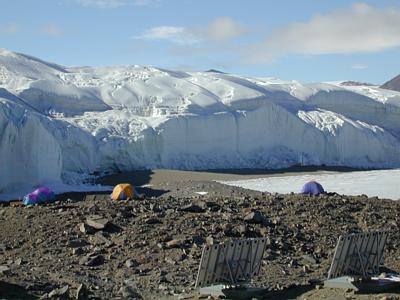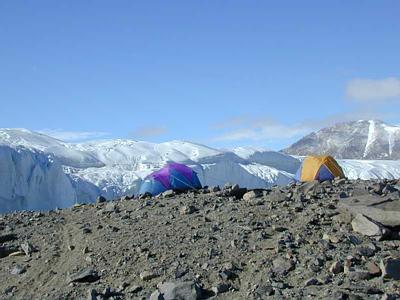25 November, 1999
Research in the dry valleys!
The McMurdo Dry Valleys are found within the chain of mountains known as the
Trans-Antarctic Mountains. This is a huge mountain range that traverses the
western side of the continent almost from the Palmer Station to McMurdo
Station. About 60 kilometers from McMurdo Station, across McMurdo Sound is
the Taylor Valley with a chain of lakes and bare valley bottom all the way
up the valley to the Taylor Glacier. There are several field camps in this
valley. We visited the Lake Hoare field camp in hopes of taking some stream
measurements as part of our work with the Schoolyard LTER. Unfortunately,
all the streams remain frozen with no water flowing at all. I could not
take any measurements at this time. We will be back to the valley at the
end of next week when I think the streams may be flowing. I can then get
some water samples and collect some data using the equipment that I brought
along from Lakeside School in Seattle. When the sun is not blocked by
clouds, it beats down on the glaciers causing some of the surface ice to
melt, run off of the glacier and flow into streams which in turn will flow
into the lakes. If there is rock debris on the glacier surface, then more
solar radiation is absorbed causing more water to flow into the streams. Of
course, all of this is dependent on the number of hours of direct sun light,
the air temperature and the wind. One big question being asked by
scientists in the McMurdo Dry Valley Long Term Ecological Research is about
material transport. How much and what kinds of chemicals, ions, and other
materials are being carried into the lakes by the melt waters flowing into
the streams and then the lakes? What ions are trapped in the snow that has
fallen on the glacier during the past year? Is there any evidence of human
activity in the meltwater from the glaciers? How important are these ions
and chemicals to the organisms living under the ice in the lakes? What other
ions does the water pick up as it flows over the rocky streambed on its way
to the lakes?
Another big question is about the energy balance. By this I refer to how
much energy is hitting the glaciers? What happens to the energy hitting the
glaciers? How much is bounced back as albedo? How much is absorbed causing
the ice to change to liquid? How does the energy influence the level of
water in the lakes? These are just a few things to think about. What would
have to happen to cause the lake level to change? Can you describe the
scenario that will cause a lowering of the lakes? This study may actually
contribute to the even bigger questions related to past, present and future
climate of earth.
Since Pete has never been to the valley, I took him on a tour of the area
around the field camp. We had the in camp briefing on the living and sharing
the work load while in camp as well. I will include some photos to show you
some of the tents and the "HUT" where Thanksgiving dinner is being prepared.
The water we will use comes from "ice berries". These are big chunks of ice
that have broken off of the Canada Glacier, are brought up to the hut and
set aside to be melted in a huge pot used just for melting water. There is
a special pair of gloves for use only to collect and handle the ice berries.
This way the drinking water and cooking water stays clean. The field camp
is powered almost exclusively by using solar panels. There is enough power
generated to provide for the lights, coffee maker, stereo, refrigerator,
microwave, computers and battery re-charger for the field radios. If the
scientists need a continuous supply of power for filtering water samples or
for other experiments, then a generator can be turned on. However, no one
wants the noisy generator turned on so everyone is really careful about use
of the power, especially on a cloudy day.
We travel to the Taylor Valley by helicopter. Everything must be weighed
including us. The helicopter is loaded, we are loaded, given helmets and a
briefing again on safety, and then we are on our way. The trip takes about
35 minutes one way. The weather seems to be better in the valleys with more
sun and fewer clouds than at McMurdo Station this time of year.

The Taylor Valley is behind me as Pete and I begin to hike up the valley. The day is warm and the ice just may start to melt along the edge so we can find some mat.

Lake Hoare field camp at the base of the Canada Glacier

While we share lab facilities, we each have our own tents in which to sleep. This is great camping with clear fresh(sort of) old water to use. Fresh because there is not much salt in it, old because it is glacier water we melt.

Most of the power used comes from the solar panels that are rotated by hand four times per day.

The Hut is where the real "home" is. Today Thanksgiving dinner is being prepared. It looks and smells like home with fresh bread baking, pies being constructed and turkey dressing waiting to be make. The camp manager cooks one meal per day for who ever is in the camp at the time. The rest of the meals are on a serve yourself bases.
Contact the TEA in the field at
.
If you cannot connect through your browser, copy the
TEA's e-mail address in the "To:" line of
your favorite e-mail package.
|
